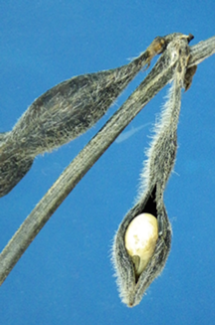What Causes Sprouting Soybeans?
Temperatures greater than 50°F and seed moisture greater than 50 percent are required for soybean seed germination. During seed fill, these conditions prevail but do not cause germination of immature seeds. Once seeds dry to near physiological maturity, abscisic acid levels allow germination during warm and wet conditions. Seed moisture is less than 50 percent once seed is mature, and germination is possible when moisture levels increase above 50 percent again with warm temperatures.1
Frequent rains, continuous drizzle, and heavy fogs soak pods to the point where seeds begin to swell. Pods do not expand much with moisture, but may be large enough to stay intact and split after seeds have germinated.1 Swollen seeds, not yet sprouted, can cause pods to open and allow even more moisture to reach seeds. Once seed moisture increases over 50 percent, germination begins and continues as long as conditions stay wet. Elongation of the embryo root is the first visible indication germination has begun.
Soybean seed sprouting can be more frequent if dry conditions prevailed during pod and seed development (R4 to R6 stages). Drought stress can result in small pods, and if followed by wet conditions during seed fill stages, can cause seeds to outgrow and split pods.2
Yield Impact
Grain quality is affected by seeds prematurely germinating. Germinated seeds die; small seedlings may break into several parts. Additionally -
- Free sugars, amino acids, and fatty acids are released during germination; these simple compounds spoil easily in storage.
- Seed coats rupture during germination; stored grain is vulnerable to invasion by fungi and insects.
- Grain storage time and official grade may be reduced.
According to the Official U.S. Standards for Grain, damaged soybeans include those which are sprouted. A grade of No. 1 or No. 2 U.S. soybeans requires less than 2 percent and 3 percent damaged seed, respectively.3
Management Considerations
Amounts of sprouted seed is usually low and yield and seed quality effects are minimal. Drier conditions are expected to cause sprouted seed to dry up and possibly fall out of pods before combining. Lower test weight or an increased level of foreign material (dried sprout pieces) are possible when loads are graded. In severe cases, light, sprouted seed could be blown out the back of the combine with air adjustments.
Sources:
1 Wiebold, W.J. 2014. Seed germination before harvest. Integrated Pest & Crop Management. University of Missouri. https://ipm.missouri.edu/IPCM/2014/10/Seed-Germination-Before-Harvest/
2 Holshouser, D. 2015. Wet conditions may lead to soybean seed sprouting. Virginia Ag Pest and Crop Advisory. Virginia Cooperative Extension. https://blogs.ext.vt.edu/ag-pest-advisory/wet-conditions-may-lead-to-soybean-seed-sprouting
3 2017. U.S. Standards. Federal Grain Inspection Service. United States Department of Agriculture.
Web sources verified 10/15/18.


